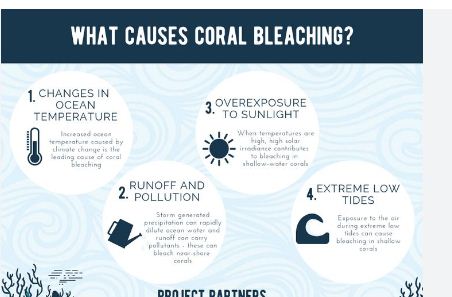April 23, 2024
Fourth global mass coral bleaching triggered: C3S/ Copernicus Programme
Why in News? The US National Oceanic and Atmospheric Administration (NOAA) has recently said that The fourth global mass coral bleaching event has been triggered by extraordinary ocean temperatures.
This event may cause serious consequences for ocean life and millions of people who rely on reefs for food, jobs and coastal defence.
The EU Copernicus Climate Change Service (C3S):
- The average sea surface temperature (SST) has been abnormally high. In March this year, it reached a record monthly high of 21.07 degree Celsius.
- The primary reason behind the soaring temperatures is the rising emissions of heat-trapping greenhouse gases (GHGs) such as carbon dioxide and methane in the atmosphere.
- Nearly 90% of the extra heat trapped by GHGs has been absorbed by the oceans — that is why they have become so warm.
What are corals and coral reefs?
- Corals are essentially animals, which are sessile, meaning they permanently attach themselves to the ocean floor. They use their tiny tentacle-like hands to catch food from the water and sweep into their mouth. Each individual coral animal is known as a polyp and it lives in groups of hundreds to thousands of genetically identical polyps that form a ‘colony’.
- Corals are largely classified as either hard coral or soft coral. It is the hard corals that are the architects of coral reefs — complex three-dimensional structures built up over thousands of years. “Unlike soft corals, hard corals have stony skeletons made out of limestone that are produced by coral polyps. When polyps die, their skeletons are left behind and used as foundations for new polyps,
- Coral reefs, also referred to as “rainforests of the sea”, have existed on the Earth for nearly 450 million years. Australia’s Great Barrier Reef is the largest in the world, stretching across 2,028 kilometres.
What is the significance of corals?
Coral reefs have a crucial role in marine ecosystems. Thousands of marine species can be found living on one reef. For instance, “the Great Barrier Reef contains over 400 coral species, 1,500 fish species, 4,000 mollusc species and six of the world’s seven sea turtle species.
What is coral bleaching?
- Most corals contain algae called zooxanthellae — they are plant-like organisms — in their tissues. Corals and zooxanthellae have a symbiotic relationship.
- While corals provide zooxanthellae a safe place to live, zooxanthellae provide oxygen and organic products of photosynthesis that help corals to grow and thrive. Zooxanthellae also give bright and unique colours to corals.
Corals are very sensitive to light and temperature and even a small change in their living conditions can stress them. When stressed, they expel zooxanthellae and turn entirely white. This is called coral bleaching.

| A bout The Copernicus Climate Change Service (C3S) /Copernicus Programme:
· It is part of the European Union’s Copernicus Programme, which is the EU’s flagship Earth observation program. C3S specifically focuses on providing comprehensive climate information to support decision-making processes related to climate adaptation, mitigation, and policy development. |
April 24, 2024
April 24, 2024
August 5, 2022
July 27, 2022
July 27, 2022
